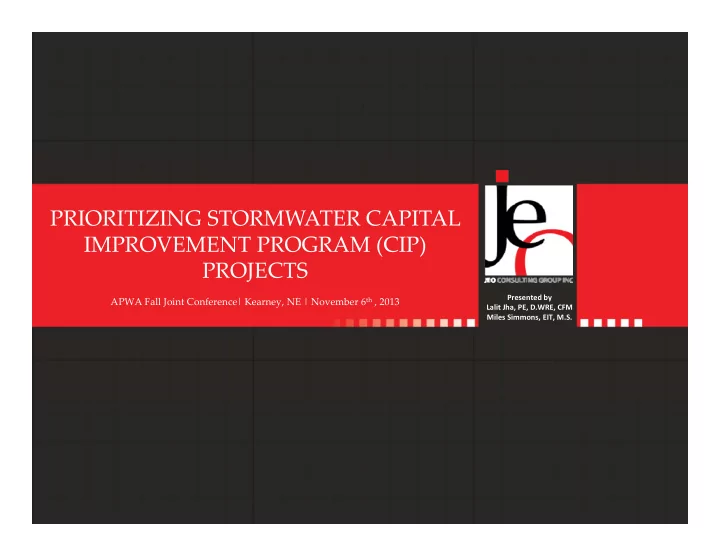

PRIORITIZING STORMWATER CAPITAL IMPROVEMENT PROGRAM (CIP) PROJECTS Presented by APWA Fall Joint Conference| Kearney, NE | November 6 th , 2013 Lalit Jha, PE, D.WRE, CFM Miles Simmons, EIT, M.S. 1
Agenda • Urban Drainage Issues • CIP Prioritization • Study Methodology • Project Benefits • Conclusion 2
Urban Drainage Issues • Flooding Problems • Structural Condition of the System • System Upgrades and Master Planning • Operation and Maintenance • Stormwater Program Financing 3
Localized Flooding 50 th and R St. 63 rd and Fletcher Ave. 4
Stormwater System Deficiencies 27 th and Highway 2 33 rd and Highway 2 5
Structural Condition 14 th and Holdrege St. 11 th and Oak St. 6
Urban Drainage Issues “How can drainage problems be identified?” “Which problems should be addressed first?” “What are the financing needs?” “Most bang for the buck” 7
Background – Lincoln, Nebraska • State Capital, second largest City in NE • Population 260,000 • 82 square miles within City limits • 500 miles of public storm drain system • 230 miles of open channel system • 31,000 ancillary items 8
Background – CIP Prioritization • Previous methodology developed in 1966 • Based on out ‐ dated standards • Reactive approach “Squeaky wheel gets the grease” 9
Project Objective Develop an updated prioritization • methodology and a proactive CIP Identify stormwater CIP projects • Enhance the City’s stormwater database • “Reduce Flooding and Drainage Issues” 10
Prioritization Approach • Written Scoring • Written Policy • Engineering Judgment / Committee Review 11
Prioritization Methodology • Prioritization Categories • Structural Flooding • Non ‐ Structural Flooding • Existing Infrastructure Condition • Miscellaneous Factors health and safety critical locations downstream impacts community development links to other utility projects 12
Prioritization Methodology Example Prioritization Worksheet 13
Previous Study Process • Data Preparation / Data Collection • Identify Deficiencies – MicroStation GeoPak Drainage – 1 ‐ D, Rational Method, steady flow • Propose Drainage Improvements • Prioritize Projects • GIS Coverage and Database – Imported from MicroStation 14
Application Studied 10,000 acres of watershed • 135 miles of pipe, 20,000 LF of open channel, • 5,000 ancillary items Identified 150 CIP stormwater projects • – Dozens of projects proceeded to design/construction through funding from 2005 ‐ 2012 Stormwater bonds 15
16 Drainage Current Urban Study
Current Study Process • Phase 1 ‐ Screening Level Analysis – 1 ‐ D, Rational Method, steady flow – Identify Storm System Deficiencies • Pipe Capacity, Inlet Ponding Depths, Ponding Limits, Structural Flooding – Update GIS Database • Phase 2 ‐ Detailed Analysis and CIP Development – Optional 2 ‐ D, unsteady flow – Develop CIP stormwater projects • Evaluate conceptual alternatives 17
Hydrology and Hydraulics ArcGIS Screenshot of DGN map XP SWMM 18
Stormwater System Deficiencies Drainage system deficiencies based on design storm as defined in City design criteria manual. Pipes (Discharge Relative to Capacity) Inlets (Ponded Depth at Inlet) Ponding Areas (Structural Flood Frequency) Street Flooding 19
20 1-D Pipes/Open Channels 1-D/2-D Analysis Flow/Flooding 2-D Overland
21 Flooding Animations
CIP Project Development Structural Flooding • Location • City Design Standards • Cost-Effectiveness • 22
23 CIP Project Development
24 CIP Project Prioritization
GIS Database Management 25
GIS Database Management 26
27 Model Validation
Conclusion • Cost ‐ effective approach to prepare a proactive stormwater CIP • Ensures taxpayers’ dollars spent on most needed projects • Helpful in justifying stormwater program financing needs to elected officials and public 28
29 Thank You! Questions?
Recommend
More recommend